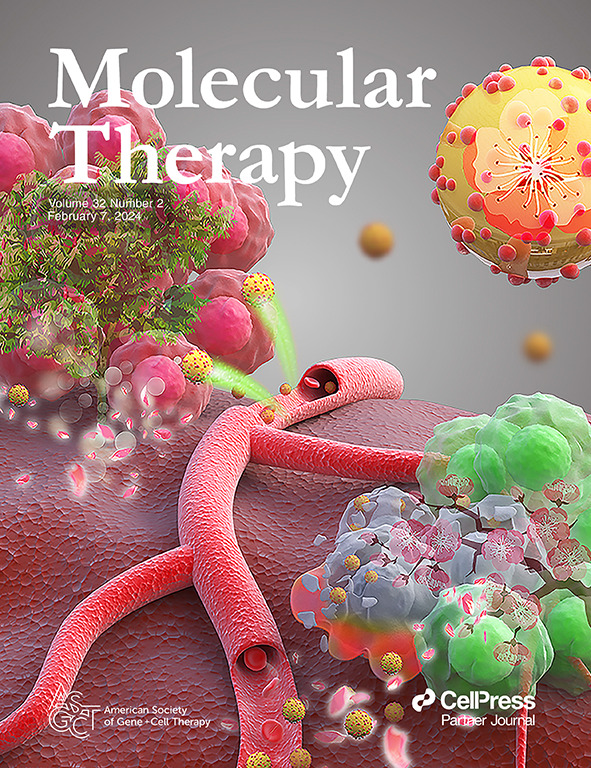Intrinsic/proximal cell surface marker logic-gated extracellular targeted protein degradation in specific cell population.
IF 12.1
1区 医学
Q1 BIOTECHNOLOGY & APPLIED MICROBIOLOGY
引用次数: 0
Abstract
Molecular tether-mediated extracellular targeted protein degradation (eTPD) presents an innovative technology and underlies a promising drug modality. However, to precisely implement eTPD within specific cell compartments remains a significant challenge. As eTPD depends on the degrader molecule expression and activity, we first seek to expand the panel of potential eTPD degraders. To this end, more than fifty receptors with variable tissue distributions are screened for identification of those with substantial endocytic rates. We subsequently assemble the bispecific, "Selected endocytic carrier-targeting chimeras (SecTAC)", and validate their efficacies to program the target cells to internalize membrane/extracellular protein cargoes (or nucleic acids). Moreover, administration of a SecTAC for removal of excessive IgG via a currently validated, emerging degrader (CD71) leads to evident therapeutic effect in a mouse lupus model. To further enhance cell-targeting specificity, we next develop logic-gated eTPD (LOG-eTPD) based on combination of chimeras that indirectly couple cargo and degrader via another cell surface gating marker. Particularly, we find that a selective surface marker from the neighboring cells may also be exploited as input for LOG-eTPD in a therapeutically relevant context. Taken together, the present work has laid strong foundation for developing eTPD agents that combine high potency with precision and safety.内在/近端细胞表面标记逻辑门控细胞外靶向蛋白降解在特定细胞群。
分子链介导的细胞外靶向蛋白降解(eTPD)是一项创新技术,是一种有前景的药物模式。然而,在特定细胞区室中精确实施eTPD仍然是一个重大挑战。由于eTPD依赖于降解分子的表达和活性,我们首先寻求扩大潜在的eTPD降解物的范围。为此,筛选了50多种具有可变组织分布的受体,以鉴定具有大量内吞率的受体。随后,我们组装了双特异性的“选择性内噬载体靶向嵌合体(SecTAC)”,并验证了它们对靶细胞进行编程以内化膜/细胞外蛋白(或核酸)的有效性。此外,在小鼠狼疮模型中,给药SecTAC通过目前验证的新兴降解物(CD71)去除过量的IgG,产生明显的治疗效果。为了进一步提高细胞靶向特异性,我们接下来开发了基于嵌合体的逻辑门控eTPD (LOG-eTPD),该嵌合体通过另一种细胞表面门控标记间接将货物和降解物偶联。特别是,我们发现来自邻近细胞的选择性表面标记物也可能在治疗相关的背景下被用作LOG-eTPD的输入。本研究为开发高效、精准、安全的eTPD制剂奠定了坚实的基础。
本文章由计算机程序翻译,如有差异,请以英文原文为准。
求助全文
约1分钟内获得全文
求助全文
来源期刊

Molecular Therapy
医学-生物工程与应用微生物
CiteScore
19.20
自引率
3.20%
发文量
357
审稿时长
3 months
期刊介绍:
Molecular Therapy is the leading journal for research in gene transfer, vector development, stem cell manipulation, and therapeutic interventions. It covers a broad spectrum of topics including genetic and acquired disease correction, vaccine development, pre-clinical validation, safety/efficacy studies, and clinical trials. With a focus on advancing genetics, medicine, and biotechnology, Molecular Therapy publishes peer-reviewed research, reviews, and commentaries to showcase the latest advancements in the field. With an impressive impact factor of 12.4 in 2022, it continues to attract top-tier contributions.
 求助内容:
求助内容: 应助结果提醒方式:
应助结果提醒方式:


